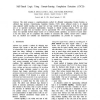Free Online Productivity Tools
i2Speak
i2Symbol
i2OCR
iTex2Img
iWeb2Print
iWeb2Shot
i2Type
iPdf2Split
iPdf2Merge
i2Bopomofo
i2Arabic
i2Style
i2Image
i2PDF
iLatex2Rtf
Sci2ools
77
Voted
ICCD
1991
IEEE
1991
IEEE
Self-Timed Logic Using Current-Sensing Completion Detection (CSCD)
This article proposes a completion-detection method for efficiently implementing Boolean functions as self-timed logic structures. Current-Sensing Completion Detection, CSCD, allows self-timed circuits to be designed using single-rail variable encoding (one signal wire per logic variable) and implemented in about the same silicon area as an equivalent synchronous implementation. Compared to dual-rail encoding methods, CSCD can reduce the number of signal wires and transistors used by approximately 50%. CSCD implementations improved performance over equivalent dual-rail designs because of: (1) reduced parasitic capacitance, (2) removal of spacer tokens in the data stream, and (3) computation state similarity of consecutive data variables. Several CSCD configurations are described and evaluated and transistor-level implementations are provided for comparison.
Equivalent Synchronous Implementation | Hardware | ICCD 1991 | Self-timed Logic Structures | Signal Wires |
| Added | 27 Aug 2010 |
| Updated | 27 Aug 2010 |
| Type | Conference |
| Year | 1991 |
| Where | ICCD |
| Authors | Mark E. Dean, David L. Dill, Mark Horowitz |
Comments (0)

